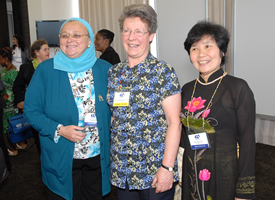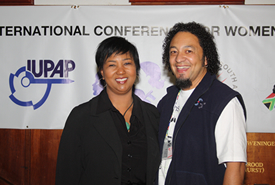| 42% of getS.E.T.go! readers think that the development of a 3D touch screen is a great idea and an exciting development for science. | |
| 17% are indifferent. | |
| 40% think it’s a waste of money and a gimmick. |
It is estimated that South Africa’s new Science & Technology Train, which is currently under development, will reach 14 000 learners each year.
Transnet Rail Engineering at Koedoespoort will complete the train’s renovations.
SA girls get a word to the wise
 |
Several renowned female physicists participated in the ICWIP 2011 programme, including Dame Jocelyn Bell-Burnell, the British astrophysicist who first discovered pulsars in 1967 (centre). On her left is Hala Hosny of Egypt and on the right Kim Anh Tran of Vietnam. |
|
 |
Astronaut Mae Jemison (left) with Dr Gillain Arendse of iThemba LABS at the outreach event for 200 girl learners. |
The global shortage of women in physics and the diverse contribution of women around the world to this field, both came under the spotlight at the fourth International Conference on Women in Physics (ICWIP), held in Stellenbosch in April.
Attended by more than 230 delegates and hosted by the International Union of Pure & Applied Physics, the ICWIP conference combined a full scientific programme with healthy debate around ways of attracting girls into physics and recruiting and retaining women physicists.
The conference provided an opportunity to explore why South Africa has so few women physicists (in 2010, all heads of university physics departments in the country were men and only 24% of all physics graduates were women). Delegates also discussed possible solutions, drawing on the perspectives of participants from about 50 different countries.
“Physics is a wonderfully stimulating profession – it needs women – and women need physics,” says Professor Diane Grayson of the University of Pretoria, programme chair for the conference.
The conference highlighted the exciting career paths that physics offers to women and reminded people of the key role that physics plays in everyday life and professions such as engineering, medicine, telecommunications and environmental sciences.
Engaging girls with physics
The conference included a weekend outreach event for more than 200 girls from schools in Malmesbury and Paarl, who met with prominent physicists to hear them talk about themselves and their careers, and to see them practice their physics.
A highlight of the event was a presentation on sound by UK physicist Ann Marks, who is widely recognised for her contribution to physics education and outreach. She demonstrated singing rods, straw oboes and other physics activities using items commonly found around the home – from coat hangers to musical boxes.
Other highlights included career and life stories of noted women physicists from around the world as well as meeting with astronaut Mae Jemison of the USA, who was the first African American woman in space.
So what can we do in South African to encourage more girls to pursue this field of study? Suggestions from the schoolgirls include:
- “Have more programmes on TV that encourage girls.”
- “Have more events like this one, because girls out there aren’t well informed.”
- “Tell girls about the opportunities; hold conferences like these, and show girls that they too can work in laboratories – they are not just for boys.”
- “Have a motivational speaker every month to tell girls how important they are and that they have the ability to do anything.”
